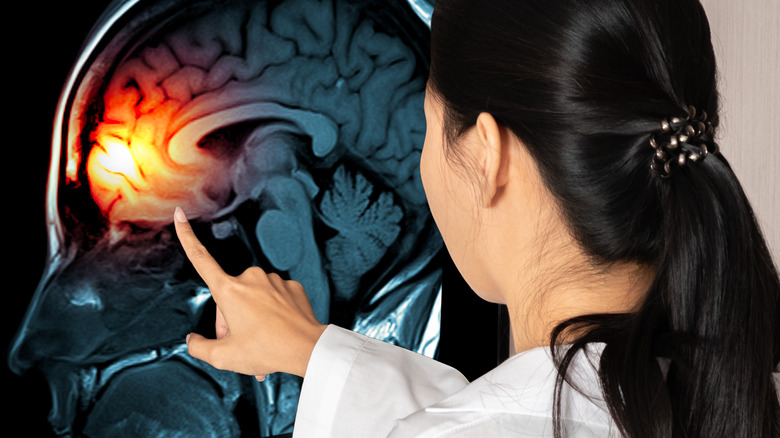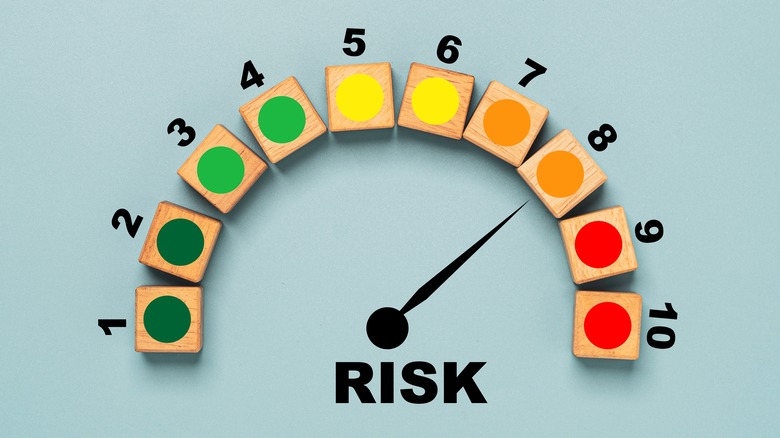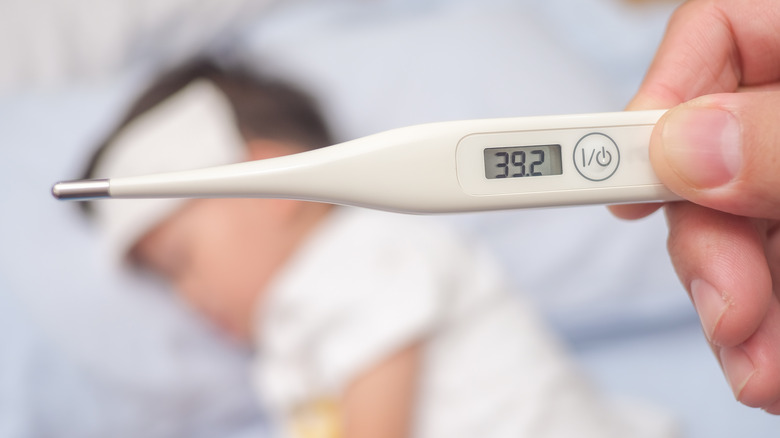12 Signs Of Meningitis B You Should Be Aware Of
Your brain and spinal cord (also known as your central nervous system, or CNS) are covered by three layers of membranes called the meninges (via the Cleveland Clinic). They are designed to protect your CNS from injury and provide support for your arteries, veins, nerves, and its surrounding fluid (your cerebrospinal fluid).
Yet, much like any other part of your body, your meninges can become infected, according to the Centers for Disease Control and Prevention (CDC). This condition, called meningitis, causes them to become inflamed, and can be fatal if left untreated. There are multiple types of meningitis, categorized based on their root cause: viral, fungal, bacterial, parasitic, amebic, and even non-infectious meningitis.
Per a 2021 review published in Current Opinion in Neurology, bacterial meningitis (meningitis B) occurs when bacteria enters your nose or mouth cavities, reaches your bloodstream, and travels all the way up to your CNS. Once there, it goes through your blood-brain barrier (BBB), a type of brain surveillance system that kills bacteria and viruses in normal conditions. When the bacteria have reached your CNS, your body "triggers a highly inflammatory, and predominately ineffective response." If the inflammation persists for a prolonged time, it may also lead to permanent brain and nerve damage and even death. This article tells you all about the most common bacterial meningitis symptoms to be aware of so that you may act quickly if you suspect you or a loved one may have it.
Risk factors for meningitis B
Out of all the different types of meningitis, bacterial meningitis is not only the most severe one, but it is also highly contagious (per Healthline), and certain factors may increase the risk of getting the disease.
Per the Centers for Disease Control and Prevention (CDC), while people of all age groups can get meningitis B, babies and young children have an increased risk. Furthermore, given its highly contagious potential, living or spending time in community or group settings, such as boarding schools, college campuses, daycare centers, homeless shelters, prisons, or senior housing also increases the risk of the disease.
In addition, due to increased exposure to meningitis-causing microorganisms, traveling or working with common bacterial strains like Streptococcus pneumoniae, Listeria monocytogenes, or Escherichia coli are also considered risk factors for getting the disease. Lastly, certain medical conditions may predispose you to meningitis, including not having your spleen or having a cerebrospinal fluid leak. Moreover, Healthline adds having a weakened immune system to the list of risk factors, as it would make it more difficult for your body to fight the bacteria. Some conditions or treatments that compromise your immune system include chemotherapy, HIV infection, bone marrow transplants, organ transplants, and immunosuppressive treatment.
Fever
Having a fever (defined as a body temperature of 38 degrees Celcius or higher, per Health Direct) is not that uncommon. After all, it is your body's way of telling you it is fending off an infection. However, according to a 2004 article published in The New England Journal of Medicine, fever is one of the main symptoms of bacterial meningitis, being present in roughly 77% of the 696 study's cases. In fact, it belongs to the so-called "classic triad," which includes symptoms like confusion and neck stiffness.
Fevers are rarely medical emergencies by themselves, and can often be treated by resting, drinking plenty of fluids, and taking acetaminophen or ibuprofen. However, they can be accompanied by mild symptoms like shivering, body aches, sweating, and dehydration, which can cause discomfort (per Healthline). Nevertheless, you should contact your healthcare provider if your temperature is higher than 39.4 degrees Celcius (or 38–39 degrees Celcius in the case of an infant or child, respectively), it has lasted more than 3 days, or if there are additional symptoms such as confusion, irritability, sensitivity to light, skin rashes, or vomiting, as those can also be an indication of bacterial meningitis.
Headache
Headaches can be caused by countless reasons, from stress, dehydration, or poor sleep to infection, high blood pressure, sinus congestion, tumor, or stroke (via Healthline). Therefore, having a headache doesn't automatically mean you have meningitis B. However, it is a very common symptom of the disease. Per a 2004 article published in The New England Journal of Medicine, headaches were reported in 87% out of 696 bacterial meningitis cases.
Regardless of how common headaches might be, there is one particular type of headache — the migraine — that, while not a usual sign of meningitis B, has numerous symptoms in common. For example, according to Health Direct, migraines are often accompanied by nausea, vomiting, and sensitivity to bright lights, all of which are characteristic of bacterial meningitis as well. Yet, what could potentially separate a common migraine from a bacterial meningitis headache is how and where you feel the pain in your head. Per the site, migraines are characterized by a throbbing or pounding pain that is more prominent on one side of the head. In contrast, headaches are felt as an even and tight pressure all around the head.
Stiff neck
Stiff neck or neck pain are very common signs of meningitis, including meningitis B. This is due to the nature of the disease, which leads to the inflammation of the meninges.
As Medical News Today explains, the meninges cover your brain and spinal cord, which goes from the back of your head, passing through your neck and reaching all the way down to your lower back. Therefore, when the meninges become inflamed, they limit your neck's usual range of movement, leading to neck stiffness and pain.
Having a stiff neck during a meningitis infection is quite common. Per a 2004 article published in The New England Journal of Medicine, this symptom was present in 83% of the study's 696 cases. Aside from limiting neck movement, which would keep you from turning your head or bending your neck, meningitis neck pain can lead to a throbbing or pounding feeling all over your spine (via Healthline). The site also explains that the way to treat a stiff neck caused by meningitis B is by treating the disease.
Nausea and vomiting
Nausea and vomiting are two individual meningitis B symptoms. Yet, while nausea is only a discomforting sensation that you might vomit, it is often an indication that you are about to do so — meaning that it sort of lets you know that you're about to throw up your stomach's contents (via Healthline). Nausea and vomiting are pretty common and can occur due to numerous reasons. However, aside from meningitis itself, they are often a result of other meningitis symptoms. For example, per the Mayo Clinic, having a high fever or even a strong headache can also make you feel nauseous or sick.
Therefore, while nausea and vomiting are rarely life-threatening, Healthline warns that you should contact your healthcare provider if they come with additional symptoms, such as confusion, stiff neck, intense headache, weakness or sluggishness, and fever over 39 degrees Celcius (which are also meningitis B symptoms). Regardless of what's causing your nausea and vomiting, you can often manage them at home by drinking plenty of fluids to avoid dehydration, eating bland foods, and resting (via the Mayo Clinic).
Photophobia
If you often find yourself hiding from strong sunlight or indoor lights, blinking often, squinting, or avoiding going out during daytime or sunny days, you may be dealing with photophobia (per Medical News Today). According to a 2013 study published in the Journal of Neuro-Ophthalmology, the term photophobia comes from the Greek words "photo" and "phobia," which translate to fear and light, respectively. However, the term is medically used to describe an abnormal or heightened sensitivity to light which may induce or intensify pain.
Photophobia, or eyes being more sensitive to light, is a symptom of a neurological or brain condition (via Medical News Today). Therefore, you could say it is an expected sign of meningitis, given the direct effects the disease has on your brain and CNS. Photophobia treatment relies on taking care of the root cause, although wearing special eyeglasses may offer temporary comfort for some people.
Confusion
Confusion or feeling disoriented is a common sign of cognitive decline, meaning that you start losing your memory and thinking or learning abilities (per Health Direct). While it tends to be associated with the early stages of dementia, confusion can also be a sign of other serious medical conditions, including meningitis B. In fact, according to Johns Hopkins Medicine, confusion is among its most common symptoms.
According to Healthline, some common signs of confusion include having slow and incoherent speech or one that is hard to understand, slurring words, forgetting where you are, what time it is, or what you are doing, and sudden agitation or mood swings. If you notice any of these symptoms in a child, friend, or loved one, be sure to seek immediate medical attention. Confusion is a high-risk symptom, and treating it quickly can help prevent unwanted and severe meningitis complications or sequelae (per the Meningitis Research Foundation).
Purplish rash
The appearance of a purplish rash is a very distinct sign of meningitis. Yet, while it tends to pop up all over the body, in some cases, it may actually never manifest (per Medical News Today).
Meningitis rash (also called petechial rash) indicates that the disease has evolved, causing blood poisoning or infection, a condition called meningococcal septicemia. Unlike other rashes, which you can feel as little bumps in your skin, meningitis rash happens because of blood that leaks out of broken blood vessels. Therefore, this type of rash remains under your skin, meaning that you cannot feel it through touch, as Medical News Today explains. Meningitis rash usually looks like small purple marks on the skin. Yet the spots can also be red, pink, or brown, or may even look like very tiny and scattered bruises.
According to the Meningitis Research Foundation, meningitis rash is classed as a high-risk symptom that needs immediate medical attention. It also explains that if you're unsure whether a rash is caused by meningitis, you could try the tumbler or glass test, in which you just have to press a clear drinking glass against it. If the marks vanish or fade with the pressure, then it most likely isn't caused by meningitis. However, you should seek emergency treatment ASAP if they don't disappear and are still visible through the glass.
Drowsiness
Sleep and immunity are very closely related. In fact, according to a 2019 review published in Physiological Reviews, sleep is often portrayed as "the best medicine" for infections, seeing that it promotes and facilitates recovery by conserving energy and strengthening your body's immune response. For that reason, it is very common to feel lethargic or drowsy if you have bacterial meningitis. In fact, according to a 2015 study published in Plos One, drowsiness is a common symptom of meningitis B in babies, stating that it was present in 34% of the study's population. Thus, the Meningitis Research Foundation notes the importance of keeping an eye out for "unusually sleepy" or "floppy" babies.
Moreover, per a 2006 study published in the Journal of Neurology, Neurosurgery, and Psychiatry, drowsiness (or sleep disorders in general) is not only a symptom of the disease, but a long-term consequence as well. The study explains that one potential explanation is due to leftover damage in the parts of the brain in charge of managing the sleep-wake cycle.
Loss of appetite
Whether it is due to an acute or short-term circumstance or a chronic medical condition, you may lose your appetite due to numerous reasons and, according to Medical News Today, bacterial infections (such as meningitis B) are a common short-term reason that may make you want to skip a meal or two. Also, the presence of other common symptoms of meningitis B, such as nausea and vomiting, can contribute to a reduced desire to eat.
According to a 2015 study published in Plos One, appetite loss is a predominant symptom in infants with bacterial meningitis, which was present in 38% of the cases. In addition, the study determined that poor feeding was "predictive" of a poor disease outcome. The thing is that losing your appetite while being sick is pretty counterproductive, seeing that it leads to a weakened immune system at a time when your body has a higher nutrient demand to fight off the disease (per a 2014 review published in Plos One). In addition, the review explains that loss of appetite in children increases their risk of malnutrition, which, at the same time, increases the risk and severity of bacterial infections. Luckily, appetite usually returns after treating the disease (per Medical News Today).
Seizures
Seizures are a result of an electrical disorder in the brain, and they tend to be uncontrolled and sudden (via the Mayo Clinic). While seizures are not exclusive to bacterial meningitis, they can be a common symptom, especially in children — although they can also happen to adults with an advanced disease (per Johns Hopkins Medicine).
According to the Meningitis Research Foundation, you should call an ambulance or go to an emergency room if a person you suspect has meningitis has a seizure, as this is a high-risk symptom that requires immediate medical attention. In addition, the Centers for Disease Control and Prevention (CDC) says that, regardless of the cause, if you witness a seizure, you should stay with the person until it ends and help them sit in a safe place. It also warns not to hold them down or put anything in their mouth that may block their airways, and to avoid giving cardiopulmonary resuscitation (CPR) or anything to eat or drink until you know they are not at risk of choking.
Bulging fontanel
When babies are born, their skull bones are not completely joined together (per Mount Sinai). Instead, there are little gaps between them, or soft spots, connected only by a thin membrane. These soft spots are called fontanels, and they are designed to allow both the brain and skull to grow during the first year of life. After the first year, the bones fuse and form a solid skull, and the fontanels disappear.
However, since meningitis is characterized by the inflammation of the membranes surrounding the brain, a bulging or swollen fontanel is a common warning sign of meningitis in babies. In fact, according to a 2019 study published in BMC Pediatrics, a bulging fontanel was present in 50% of the study's 503 patients diagnosed with bacterial meningitis. According to Medical News Today, a bulging fontanel is often accompanied by fever. Furthermore, since it indicates a severe medical condition, it should be treated immediately to avoid serious and permanent long-term consequences.
Meningitis B prevention and treatment
As contagious and deadly as bacterial meningitis can be, it can also be prevented and treated. According to the World Health Organization (WHO), vaccination is key for bacterial meningitis prevention. It states that their health goals towards defeating meningitis by 2030 include eliminating its epidemic, reducing the number of vaccine-preventable meningitis B by 50% and deaths by 70%, and reducing meningitis-caused disability.
Per the NHS, meningitis vaccines are made from proteins found on the surface of meningitis-causing bacteria. By injecting it into your body, your immune system creates a specific defense response that can protect you from future exposure to real bacteria. They are believed to protect against nearly 90% of this kind of pathogenic bacteria. Additionally, there are multiple vaccines available for different bacterial strains and age groups.
Aside from vaccines, antibiotics can also be used as another way to reduce the risk of transmission, yet they're mostly reserved for cases when there has been close contact with a sick person, such as a member of the same household, significant other, or parents of sick babies (per WHO). Regarding its treatment, a 2021 review published in Current Opinion in Neurology states that the sooner healthcare professionals recognize the infection and start antibiotic treatment, the fewer complications and deaths from meningitis B. Furthermore, additional medications to reduce inflammation may help reduce damage to the CNS, as well as secondary complications of bacterial meningitis (including deafness, stroke, epilepsy, and learning difficulties).













